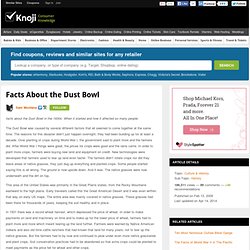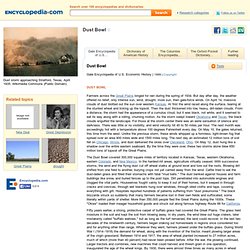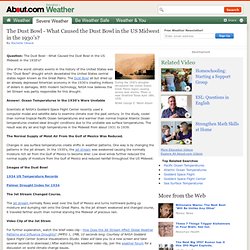

Facts About the Dust Bowl. Facts about the Dust Bowl in the 1930s.

When it started and how it affected so many people. The Dust Bowl was caused by several different factors that all seemed to come together at the same time. The reasons for this disaster didn’t just happen overnight, they had been building up for at least a decade. Over planting of crops during World War I, the government said to plant more and the farmers did. Encyclopedia.com articles about Dust Bowl. Farmers across the Great Plains longed for rain during the spring of 1934.

But day after day, the weather offered no relief, only intense sun, wind, drought, more sun, then gale-force winds. On April 14, massive clouds of dust blotted out the sun over western Kansas. At first the wind raced along the surface, tearing at the stunted wheat and licking up the topsoil. Then the dust thickened into low, heavy, dirt-laden clouds. From a distance, the storm had the appearance of a cumulus cloud, but it was black, not white; and it seemed to eat its way along with a rolling, churning motion. Mental_floss Blog » 12 Things You Might Not Know About the Dust Bowl.
In the 1930s, the United States faced one of its greatest natural disasters. The farmers in the High Plains had turned over too much soil too fast, leaving over 100 million acres stripped of its native Buffalo Grass and barren of crop. Combine this with one of the driest summers on record and you have what came to be known as the Dirty Thirties. 1. "Alfalfa Bill" Murray, a governor from Oklahoma (one of the hardest hit states), ran for President in 1932 under the platform "Bread, Butter, Bacon, Beans. " During a time when most people were eating various forms of wheat three times a day, bacon and beans were powerful words. 2.
Dust Bowl - Causes of the Dust Bowl - Drought in the Midwest. Question: The Dust Bowl - What Caused the Dust Bowl in the US Midwest in the 1930's?

One of the worst climatic events in the history of the United States was the "Dust Bowl" drought which devastated the United States central states region known as the Great Plains. The Dust Bowl all but dried up an already depressed American economy in the 1930's creating millions of dollars in damages. With modern technology, NASA now believes the Jet Stream was partly responsible for this drought.
Answer: Ocean Temperatures in the 1930's Were Unstable Scientists at NASA's Goddard Space Flight Center recently used a computer model and satellite data to examine climate over the past century. Tsme. A complex set of interacting forces both economic and ecological brought the migrant workers documented in this ethnographic collection to California.

Following World War I, a recession led to a drop in the market price of farm crops and caused Great Plains farmers to increase their productivity through mechanization and the cultivation of more land. This increase in farming activity required an increase in spending that caused many farmers to become financially overextended. The stock market crash in 1929 only served to exacerbate this already tenuous economic situation. Many independent farmers lost their farms when banks came to collect on their notes, while tenant farmers were turned out when economic pressure was brought to bear on large landholders. The attempts of these displaced agricultural workers to find other work were met with frustration due to a 30 percent unemployment rate. The Dust Bowl of the 1930s. The Dust Bowl The most visible evidence of how dry the 1930s became was the dust storm.

Tons of topsoil were blown off barren fields and carried in storm clouds for hundreds of miles. Technically, the driest region of the Plains – southeastern Colorado, southwest Kansas and the panhandles of Oklahoma and Texas – became known as the Dust Bowl, and many dust storms started there. But the entire region, and eventually the entire country, was affected. The Dust Bowl got its name after Black Sunday, April 14, 1935. "The impact is like a shovelful of fine sand flung against the face," Avis D. Soil Erosion. Scenes From the Dust Bowl - Photo Gallery. Dorothea Lange Photos. Dust Bowl Photographs.